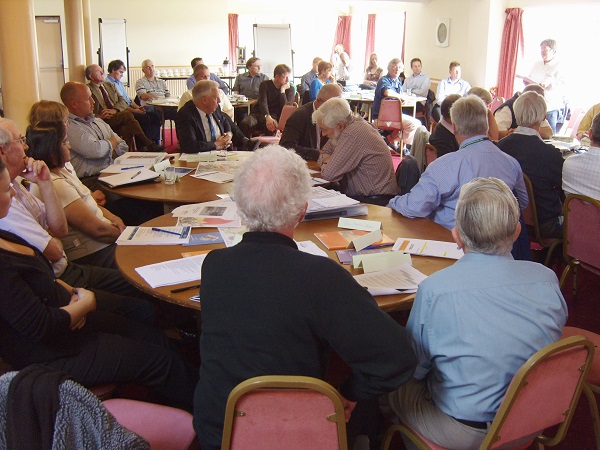What can be done?
Identify the nature of the problem in your area

Community flood workshop © Environment Agency
Consider the vulnerabilities of neighbourhoods in your area using the Climate Just map tool as a starting point for understanding the community needs in your area.
Identify the magnitude and likelihood of hazards associated with the changing climate, including flooding and heat-waves.
- Consider how patterns of vulnerable groups and those who are less likely to engage with information about climate change compare with patterns of potential exposure to flooding and heat-waves (see the Map tool and Quick Guide)
- Draw on existing risk assessments, adaptation tools such as the UKCP09 projections and its successor UKCP18 which will update the UKCP09 projections over UK land areas and for sea level rise, giving greater regional detail, as well as other local information (for example following the UKCIP Local Climate Impacts Profile (LCLIP) process). See this example of an LCLIP for Greater Manchester.
- Examine the impacts of extreme weather events including their location, timing, costs and the effectiveness of responses by using the Severe Weather Impacts Monitoring System (SWIMS) tool to record local experiences and support continuous learning.
Review the Case studies section to see what others have done.
Consider the following actions to help build resilience in vulnerable communities through raising awareness, engagement and empowering community action.
Identify existing organisations, including current service providers, voluntary and community organisations and other active groups who work directly with people who are vulnerable to climate impacts. Seek to engage them in discussions about the nature of the issues and opportunities to develop strategic responses at a local level. These could include environmental action groups, or local flood resilience fora where they exist but also other groups such as neighbourhood forums or residents' associations.
Consider whether sections of the community are not well represented and if they could be brought into discussions, for example, through engagement with faith groups, schools or other routes, and whether any new group could be established to support their engagement.
Develop awareness raising initiatives that reach all members of society. Broad public awareness raising measures are important in building more resilient communities. In addition, specially tailored awareness raising and communication are needed for specific vulnerable groups as blanket targeting of specific geographical areas or people may not be enough. For example:
- Older people. More information about why older people are considered socially vulnerable
- People on lower incomes and why they are more socially vulnerable
- Tenants. More information about why tenants are a socially vulnerable group
Work with existing voluntary and community sector groups in your area to develop broader community engagement to raise awareness and identify potential responses. Existing voluntary groups have wide networks and committed volunteers who understand the benefits of community engagement and are used to communicating with a range of people in the local area. Local Councils for Voluntary Action, which act as an advocacy and support organisation for local voluntary bodies could be targeted as a starting point to find out more about voluntary activity in the local area. The National Council for Voluntary Organisations has been working with voluntary and community organisations to support them to consider the implications of climate change for their services and the people they work with.
See the Further Resources in Section 5 above for more information.

Built by:

© 2014 - Climate Just
Contact us
